An Old Moon Grants Good Geminids Viewing, the Great Conjunction Grows Closer, and Queen Cassiopeia’s Jewels!
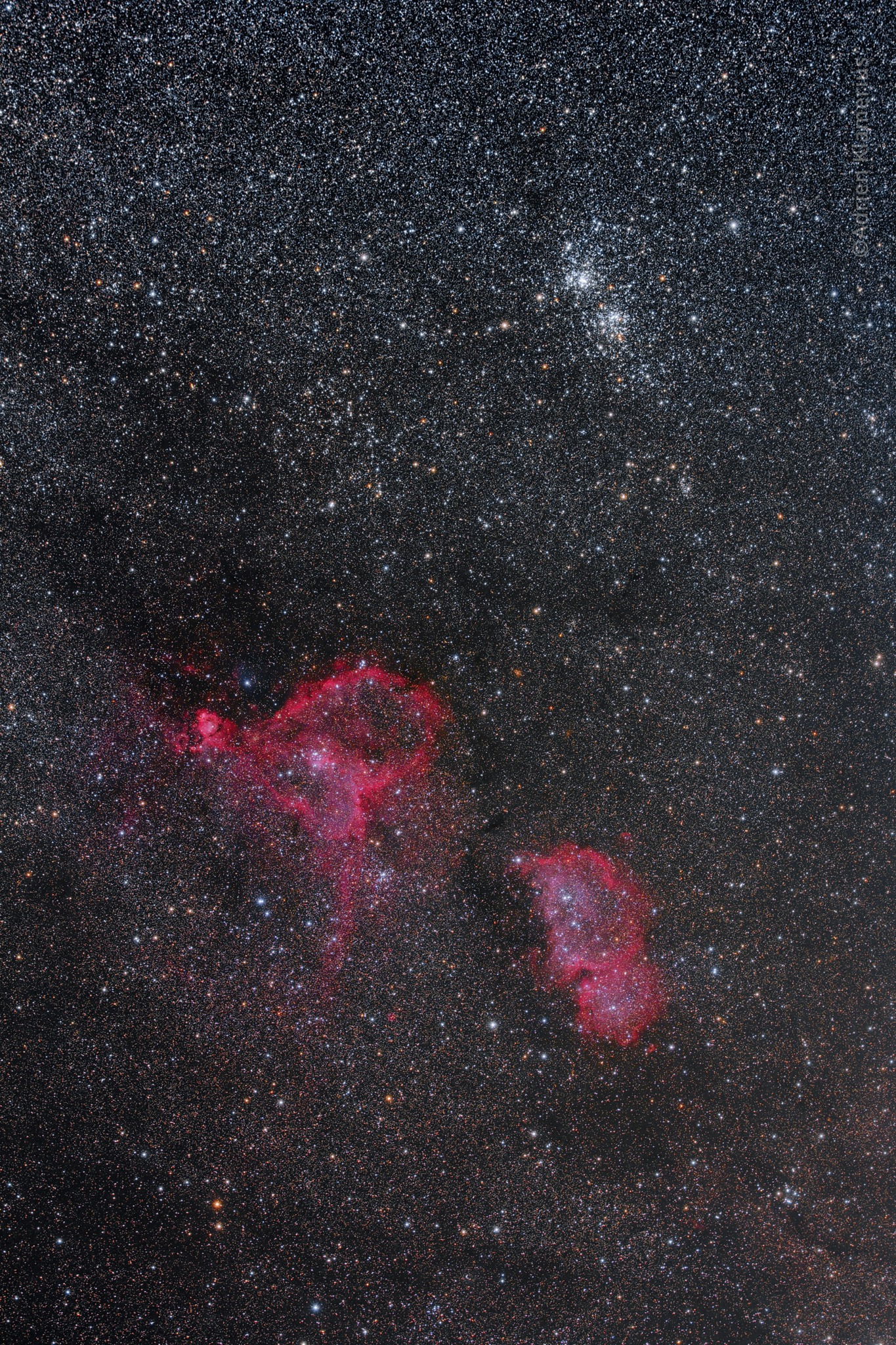
The glowing red hydrogen in the Heart and Soul Nebulas, and the bright stars of the Double Cluster above them, are featured in this image by Adrien Klamerius, which spans about 10 degrees (or a fist’s diameter) of the sky. NASA APOD for September 24, 2016
Hello, December Stargazers!
Here are your Astronomy Skylights for the week of December 6th, 2020 by Chris Vaughan. Feel free to pass this along to your friends and send me your comments, questions, and suggested topics. You can also follow me on Twitter as @astrogeoguy! Unless otherwise noted, all times are expressed in Eastern Time. To subscribe to these emails please click this MailChimp link.
I can bring my Digital Starlab portable inflatable planetarium to your school or other daytime or evening event, or teach a session online. Contact me through AstroGeo.ca, and we’ll tour the Universe, or the Earth’s interior, together!
The moon will spend this week waning in the pre-dawn sky, leaving worldwide evening skies dark for seeing the Geminids meteor shower peak on December 13-14, and to tour the jewels of Cassiopeia, the Queen. The bright planets Jupiter and Saturn continue to move closer together in the western post-sunset sky, while Mars and the ice giants shine on high, and Venus gleams in the east before sunrise. Read on for your Skylights!
Even though the December Solstice is still two weeks away, mid-northern latitudes will see the earliest sunsets of the year this week – at 4:40 pm EST in Toronto. The offset is due to Earth’s elliptical orbit. Conversely, the latest sunrise happens two weeks after the solstice.
Meteor Shower News
The Geminids Meteor Shower, always one of the most spectacular of the year, runs from December 4 to 16 annually. The Geminids will ramp up to a peak number of meteors after midnight on Sunday night, December 13, and then the shower will rapidly taper off during the following days. You can expect to see more and more Geminids meteors each night as we approach next Sunday-Monday – so keep an eye to the sky if you are outside on any clear night this week.
This year we’ll have moonless skies on the peak night, when up to 120 meteors per hour are possible under dark sky conditions. Geminids meteors are often bright, intensely coloured, and slower moving than average because they are produced by sand-sized grains dropped by an asteroid designated 3200 Phaethon.

To see the most meteors during any shower, find a safe, wide-open, dark location, preferably away from the city lights, and just look up with your unaided eyes for a good long while. Binoculars and telescopes are not useful for meteors – their field of view are too narrow. Try not to look at your phone’s bright screen because it’ll ruin your night vision. And keep your eyes heavenward, even while you are chatting with companions. My last Insider’s Guide to the Galaxy stream was all about meteors and meteorites. It’s on YouTube here.
The Moon
This week, the moon will be out of the evening sky worldwide because it is in the pre-dawn sky – heading towards its monthly meet-up with the sun next Monday. That will leave the skies nice and dark for deep sky observing and Geminids meteors!
Tonight (Sunday), our celestial sibling will rise among the stars of Leo (the Lion) at about 11 pm local time, and then it will remain visible as a half-illuminated orb in the daylit sky until late morning. On each consecutive day this week, the moon’s eastward orbital motion will reduce its angle from the morning sun – causing the moon to wane in illuminated phase, rise later, and set later. (You can safely view the moon in daytime through your binoculars or a telescope as long as you strictly avoid pointing the optics anywhere near the sun. Parental supervision is a must here.)
The moon will officially reach its last quarter phase at 7:37 pm EST on Monday, December 7. (That’s 0:37 GMT on Tuesday, December 8.) At last quarter, the moon is illuminated on its western side, towards the pre-dawn sun. Last quarter moons are positioned ahead of the Earth in our trip around the sun. About 3½ hours later, Earth will occupy that same location in space.
In the wee hours of Tuesday, the moon will exit Leo for Virgo (the Maiden). The moon will take until Friday to traverse that elongated constellation. On Saturday morning, early risers can enjoy a pretty pairing of the slim, crescent moon sitting only a few finger widths above the bright planet Venus in the east-southeastern sky among the stars of Libra (the Scales). The moon and Venus will fit together within the field of binoculars. For several hours following sunrise, sharp eyes can look for Venus’ bright point of light shining a short distance to the left of the moon in daylight. At approximately 22:00 Greenwich Mean Time on December 12, the moon will cross in front of (or occult) Venus for observers in easternmost Russia, Hawaii, and western North America.
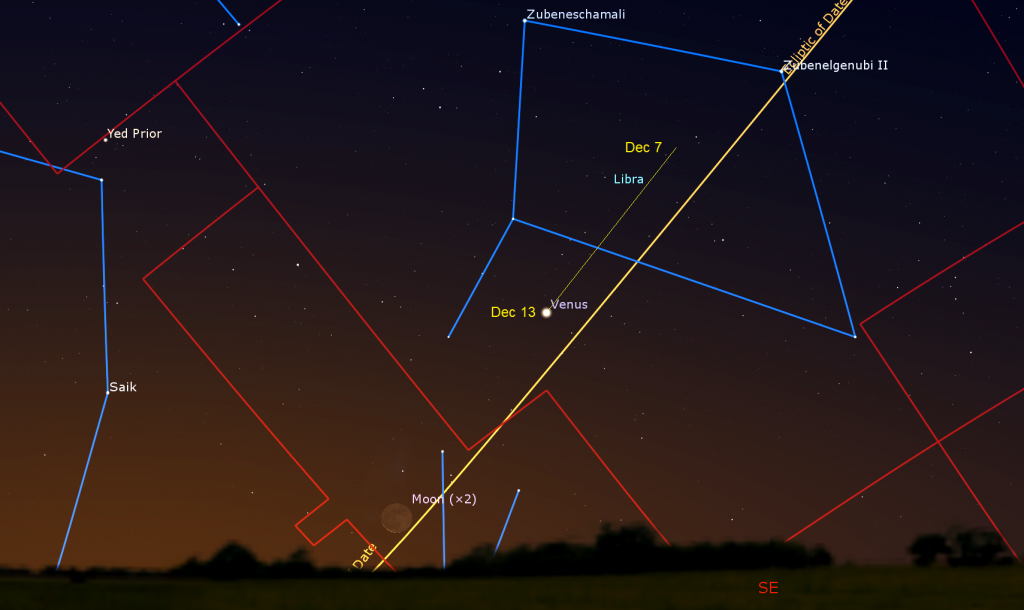
On Sunday morning, the moon will have shifted a fist’s diameter to the lower left (or 9 degrees to the celestial east) of Venus. Because the moon will rise only a short while before sunrise, you’ll need clear skies toward the east and an unobstructed view over the horizon to see it.
The Planets
The so-called Great Conjunction is building to its climax on December 21, when Jupiter and Saturn will look like a single, bright ”Solstice Star” shining in the western sky after sunset, and the two gas giant planets will appear together in the eyepiece of a telescope at low magnification!
Because Jupiter is closer to the sun than Saturn is, Jupiter is moving eastward faster than Saturn. It’ll catch up and then pass Saturn on December 21. In the meantime, watch their separation decrease every week. As the sky begins to darken each night, look for very bright, white Jupiter shining in the lower part of the southwestern sky. Yellow-tinted Saturn is smaller in size and farther away than Jupiter – so it shines about 12 times less brightly than Jupiter – delaying its appearance until the sky is darker. Tonight (Sunday), the yellowish ringed planet will sit about a thumb’s width to Jupiter’s upper left (or about 1.6 degrees to the celestial east). Next Sunday night, they will only be a finger’s width (or 0.9 degrees) apart.
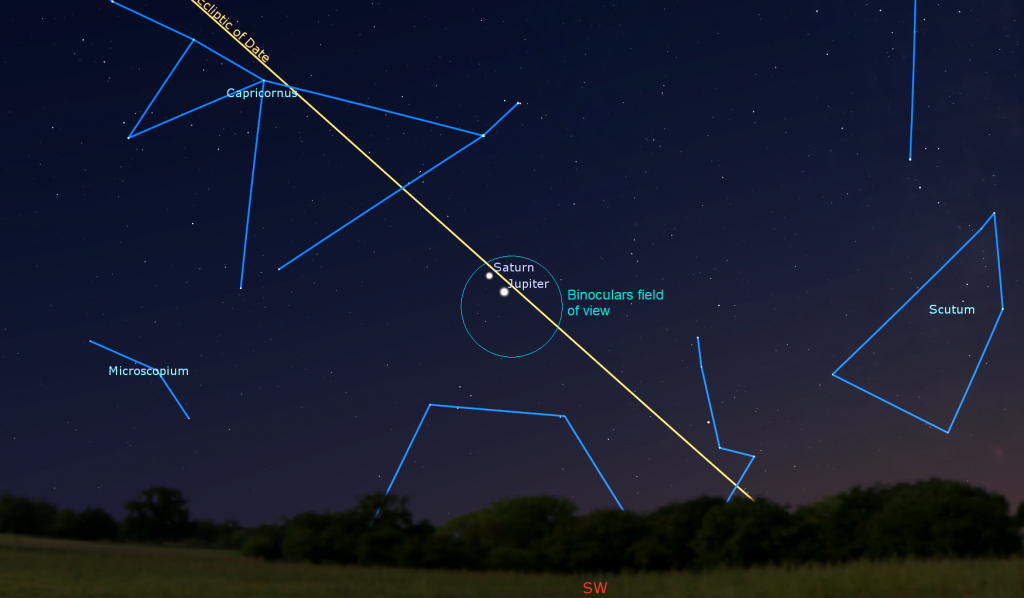
Jupiter orbits the sun once every 11.86 years, while Saturn takes 29.44 years to complete one orbit. When you crunch the numbers, those two planets meet up, on average, every 19.76 years, as viewed from Earth. (Our view of them from the moving Earth complicates the math a little.) Since each planet’s orbit is inclined a different amount from the plane of the solar system, Jupiter usually sits about a finger’s width above or below Saturn when it slips past.
This meeting is particularly close. On December 21, they’ll be only 6.25 arc-minutes, or 0.1 degrees apart. They haven’t been this close together since July 16, 1623, when they were only 5 arc minutes apart. At that time, Galileo had been using his telescope for only a few years! Our next 6-arc minute separation will occur on March 15, 2080. I’ll prepare some simulated views in upcoming Skylights. By the way, some speculate that a close pairing like this (or an even rarer triple planet conjunction) could explain the Biblical story of the star the Magi followed.
Start enjoying views of those two planets in your binoculars and telescope now, while they are farther from the sun. That’s because every night carries them closer to the post-sunset twilight. Thankfully, the earlier sunsets are granting us a little more viewing time. You should be able to locate the planets by about 5:30 pm local time. An hour later, they will be getting quite low in the southwestern sky, and therefore shining through a much thicker blanket of Earth’s distorting atmosphere. You might even see them twinkle a little bit before they set!
Backyard telescopes of any size, or good binoculars, should let you see the four large Jupiter moons that Galileo Galilei discovered in January, 1610. Named Io, Europa, Ganymede, and Callisto, they dance around the planet from night to night – although one or more can be hidden by Jupiter at any given time. The telescope will also be able to show you Saturn’s rings, and possibly Saturn’s largest, brightest moon, Titan!
Back in June and July, when they were moving retrograde westward, Jupiter and Saturn passed close to a globular star cluster named Messier 75 (or M75). Now that the two planets have resumed normal eastward motion, they are passing that cluster again. This week, in binoculars or telescopes, look for a faint fuzzy patch located less than two finger widths to the left (or 2 degrees to the celestial southeast) of Jupiter. Try to see the globular cluster at about 6 pm local time – when it’s higher, and the sky has darkened fully. Use a low magnification eyepiece in your telescope, and scan around, keeping Jupiter and Saturn near the edge of the circular field of view. Messier 75 will be in the same field of view as the planets – but where it sits will depend on the way your telescope flips and/or inverts the image.
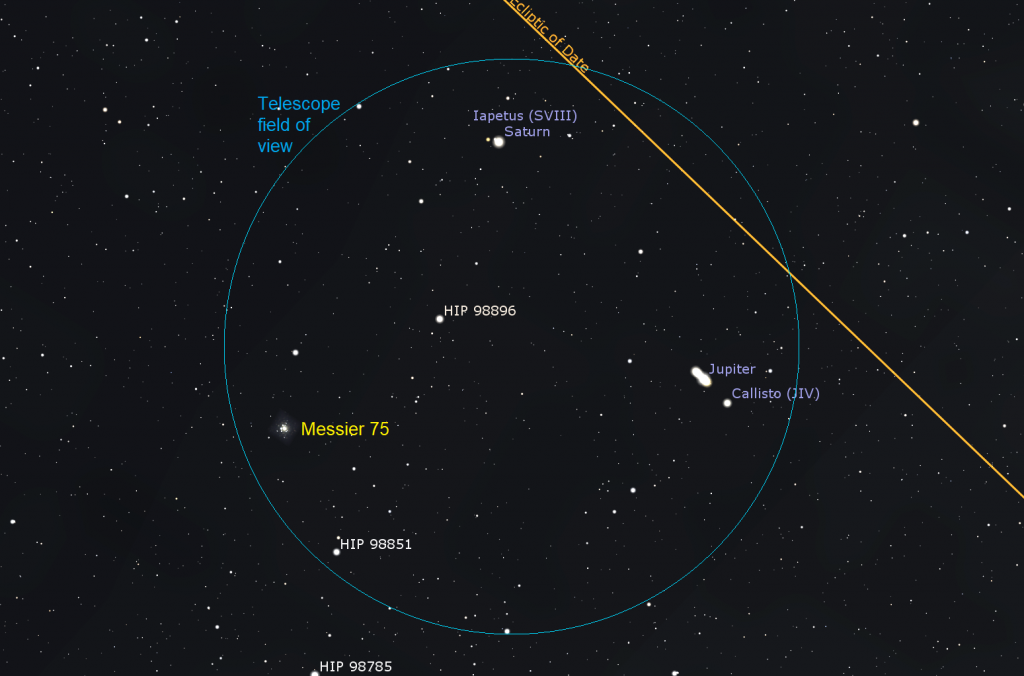
Mars is still a wonderful evening target! This week, the bright, reddish-tinted planet will already be shining in the lower part of the southeastern sky after dusk. Mars will climb to its highest point and best viewing position – more than half-way up the southern sky – shortly after 8 pm local time. Mars will set in the west during the wee hours. The planet is moving slowly eastward, and will move to inside the V-shaped stars of Pisces (the Fishes) at mid-week. Mars is rapidly fading in brightness and size from this point forward – so view it at the earliest opportunity.
Blue-green Uranus is among the stars of southern Aries (the Ram) – a fist’s diameter below and between Aries’ two brightest stars Hamal and Sheratan. For context, that region of the sky is just less than two fist diameters to the left (or 18° to the celestial east) of Mars. At magnitude 5.7, Uranus is usually within reach of backyard telescopes, binoculars, and even sharp, unaided eyes – especially with the bright moon out of the evening sky.
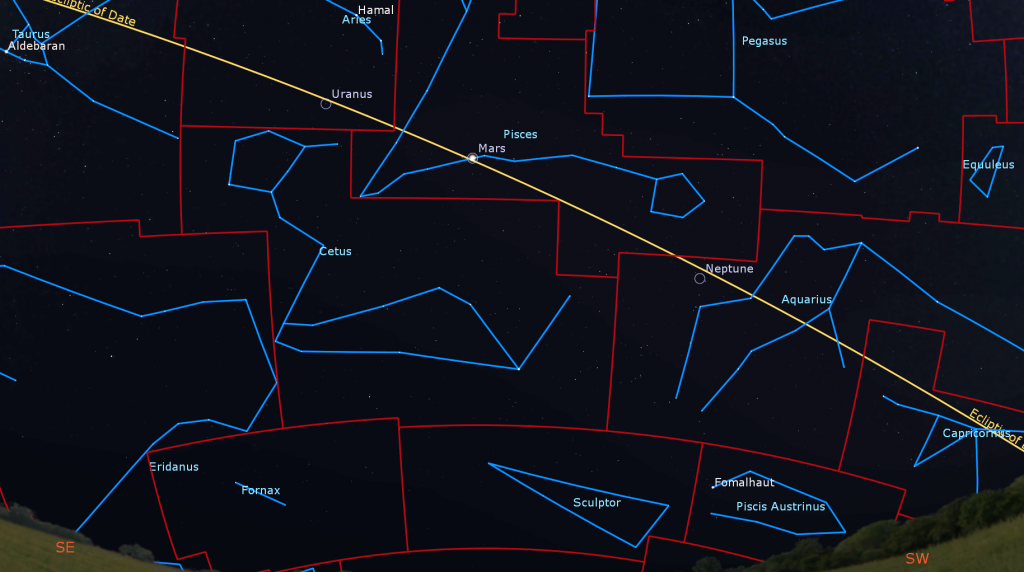
Deep blue Neptune is located about three fist diameters to the lower right (or 31 degrees to the celestial west) of Mars – to the left of the stars of northeastern Aquarius (the Water-Bearer). The dim, magnitude 7.86 planet is sitting less than a finger’s width to the upper left (or 0.7 degrees to the celestial east) of the medium-bright star Phi Aquarii or φ Aqr. This week, dim and distant planet will already be in the lower southeastern sky after dusk. It will climb a little higher until 6:20 pm local time, when you’ll get your clearest view of it while it’s almost halfway up the southern sky, then descend into the western sky to set at around midnight.
Venus has been gleaming in the eastern pre-dawn sky for some time now. It will rise at about 5:30 am local time this week, and then remain visible in the eastern sky until sunrise while it is carried higher by the rotation of the Earth. Viewed in a backyard telescope, Venus will show a slightly less than round shape. This week, the planet will be traveling down (or celestial eastward) – through the stars of Libra (the Scales). Venus is shifting towards the sun – but the later sunrises at this time of year will allow it to shine in a dark, pre-dawn sky until later this month!
Cassiopeia – Andromeda’s Story in the Stars
The late fall and early winter evening sky features a group of easy-to-see constellations that are the characters in a grand story from Greek mythology – Princess Andromeda and the hero Perseus. If you missed the story, and last week’s tour of Andromeda, I posted it here. This week’s moonless sky will be ideal for exploring the nearby constellation of Cassiopeia.
In Greek mythology, Cassiopeia was the queen of Aethiopia, married to King Cepheus, and mother to Andromeda. As a consequence of the events that led to last week’s story, the queen and her husband were eventually banished to the stars, never resting as they circle the spinning north celestial pole – and spending half of the time hanging upside down!

Cassiopeia is circumpolar – so close to the North Celestial Pole and therefore the North Star, Polaris that Canadians and other mid-latitude observers never see the constellation set. On early winter evenings, her distinctive, crooked “W” of five bright stars, each about four finger widths from the next, is situated high the northern sky (or just above the northern horizon, if you live closer to the equator) – ideal for viewing her treasures through the minimum amount of disturbing atmosphere.
If you face north after dusk, you’ll find Cassiopeia’s W oriented upside-down, appearing more like a tilted “M” with its lower, right-hand peak squashed. By 8 pm local time, the constellation will be more horizontal. Many world cultures have interpretations for this distinctive set of bright stars. A Cree story tells of a hunter named Ponoka who killed a great elk, shared the meat with his community, and then staked out the skin to dry it. Later, to honour the majestic beast, he threw the skin high into the sky. The constellation’s bright stars represent light beyond the skin shining through the stake-holes. The Inuit saw a blubber oil lamp and stand. The Navajo saw a female form that revolved around the pole. Pacific Islanders saw a great bird. Biblical scholars replaced the queen of Aethiopia with Bathsheba, Mary Magdalene, and others.
In Western classical astronomical charts, Cassiopeia is depicted as sitting in a chair or throne while combing her hair, or looking into a mirror. The bright star at the left-hand (or western) tip of the constellation is named Caph (“the hand”). Also designated Beta Cassiopeiae, or β Cas, it is a yellow-white star located 54 light-years away from us. This aging star is beginning its transition to a red giant. (In his star atlas Uranometria, published in 1603, the German astronomer Johann Bayer assigned Greek letters to each constellation’s stars, ranked in descending order of brightness.)

The bright star located second from the left, and marking the higher point of the “M” is named Shedir or Shedar, Arabic for “breast”. Even though its Bayer designation is Alpha Cassiopeiae, or α Cas, its magnitude of 2.2 can be outshone occasionally by another of Cassiopeia’s stars (see below). Shedir is also an aging giant star. It is located 229 light-years away from us. Viewed in binoculars, you’ll see that Shedir is an orange-ish colour and it has a small companion sitting to its lower left.
The star that marks the queen’s waist in the middle of the constellation doesn’t have an Arabic name. Instead it is designated Gamma Cassiopeiae or γ Cas. It also has the unofficial nickname Navi, which is Apollo astronaut Gus Grissom’s middle name spelled backwards. This white star is located 549 light-years from us, and shines with a brightness that varies irregularly due to a high rate of spin and periodic gas ejection. At the moment, magnitude 2.15 Gamma is shining a little brighter than Shedir and Caph. In binoculars, look for a very orange or reddish star named HIP 3988 sitting a short distance below Navi.
Cassiopeia’s fourth star from the left, and the shallower point of the “M”, is named Ruchbah or Rukbat (“knee”). Bayer assigned it Delta (δ). Ruchbah is a whitish colour, eclipsing binary star located only 99 light-years away from us. It shines a little less bright when an orbiting dimmer companion star partially blocks its light every 25 months.
The last of the Cassiopeia’s five brightest stars is Epsilon Cassiopeiae or ε Cas. It marks the queen’s feet. Its proper name Segin, is of unknown origin. This modest looking, magnitude 3.35 star, is actually a blue-white giant located about 440 light-years away. It’s six times the mass of our Sun, but 2,500 times more luminous! This rapidly spinning star is shedding a ring of matter around it.
See if you can spot the medium-bright, magnitude 3.45 star between Shedir and Navi. That’s Achird, or Eta (η) Cassiopeiae, the queen’s mirror or comb – although some sources claim that the name means “girdle”. Achird is a yellow, sunlike star located only 19 light-years from Earth. On the opposite side of Shedir from Achird is dimmer Fulu, or Zeta Cassiopeiae, a hot, blue star located nearly 600 light-years away from us. The last named star in Cassiopeia is Marfak, or Theta Cassiopeiae. Marfak is located about four finger widths to the upper right (or 4.5 degrees to the celestial south) of Shedir. It’s a widely-spaced double star. Its companion can be spotted sitting just to its upper left.
The outer rim of our Milky Way galaxy passes directly through Cassiopeia, meaning that the area is rich in interesting objects and star fields. One of my favorite objects can be seen in binoculars or a backyard telescope. It’s an open star cluster designated NGC 457, but I prefer its common names – the Owl Cluster, ET Cluster, or Dragonfly Cluster. The cluster was discovered by William Herschel in 1787 and is positioned more than 7,900 light-years away from us! It consists of two prominent, brighter yellow stars that form the eyes. A sprinkling of dimmer stars forms the owl’s body and feet, and two curved chains of stars look like upswept wings.

Be aware that the critter is positioned with its head pointing away from Cassiopiea. This will be the case in binoculars, but your telescope will flip the image. Locate the owl by taking Navi and Ruchbah and making them the two vertices of a right-angle triangle. The cluster sits at the third vertex, where the 90 degree corner is. It’s about four finger widths above Ruchbah – as if the queen is bouncing a baby owl on her knee!
Sweep your binoculars a few finger widths to Caph’s upper left and look for a dense knot of faint stars named Caroline’s Rose (NGC 7789). Another bright star cluster named NGC 129 sits between Caph and Navi. Located outside of the border of Cassiopeia, a generous palm’s width to the upper right of Ruchbah, you’ll find the spectacular and very bright Double Cluster. It is visible with unaided eyes, and really pops in binoculars.
Owners of large telescope can look for the large nebulas that reside in Cassiopiea. Extending a line from Shedar to Caph by a distance equal to their separation brings you to the small, bright Bubble Nebula (NGC 7635) and the Salt-and-Pepper Cluster (NGC 7654). Search a thumb’s width to the right of Shedar for the Pacman Nebula, a pink cloud of htdrogen gas with a certain distinctive shape. About a palm’s width to the right of the star Segin, near the far right of the constellation’s official boundary, are the spectacular Heart Nebula and Soul Nebula. Although they will both fit into one binoculars field of view, they are very faint, and are best captured in long exposure photographs. Perhaps they are the slippers the queen has kicked off! If there are astronomers on a planet around our nearest star, Rigel Kentaurus (aka Alpha Centauri), they will see our sun as a yellow star situated in the space between the Heart and the Soul!
While you’re gazing at the queen’s treasures, use the left half of Cassiopeia as an arrowhead that points directly towards the great Andromeda Galaxy. The galaxy is approximately 1.5 fist widths from the tip of the arrow. At 2.5 million light years away, its faint smudge is among the farthest objects visible to unaided human eyes. Under dark skies, you might be able to detect it as a glowing patch that spans more than two finger widths across, or several full moon diameters. In actuality, it measures six moon diameters across and two moon diameters wide!
Public Astro-Themed Events
Every Monday evening, York University’s Allan I. Carswell Observatory runs an online star party – broadcasting views from four telescopes/cameras, answering viewer questions, and taking requests! Details are here. Their in-person Wednesday night viewing has been converted to online via the observatory Youtube channel, where they offer free online viewing through their rooftop telescopes, including their new 1-metre telescope! Details are here.
On Wednesday evening, December 9 at 7:30 pm EDT, the RASC Toronto Centre will live stream their monthly Recreational Astronomy Night Meeting at https://www.youtube.com/rasctoronto/live. Talks include the Sky This Month, and talks about a robotic telescope and Galileo Galilei. Details are here.
On Thursday evening, December 10 from 7 to 8:30 pm, Space Place Canada will livestream a free presentation moderated by Randy Atwood entitled Canada & the Final Frontier: Looking Forward to Canada’s Future in Space. The registration and detail links are here.
My free, family-friendly Insider’s Guide to the Galaxy webcasts with Jenna Hinds of RASC National will return on Tuesday, December 15. We’re going to talk about binoculars and winter binos targets! You can find more details, and the schedule of future sessions, here and here.
Keep looking up, and enjoy the sky when you do. I love questions and requests. Send me some!